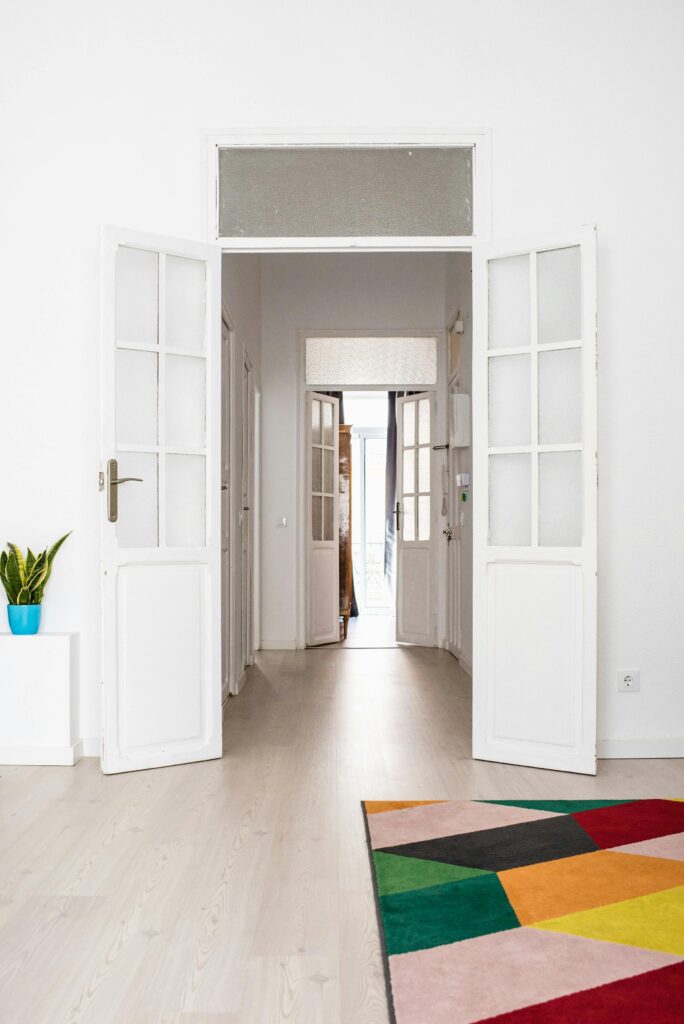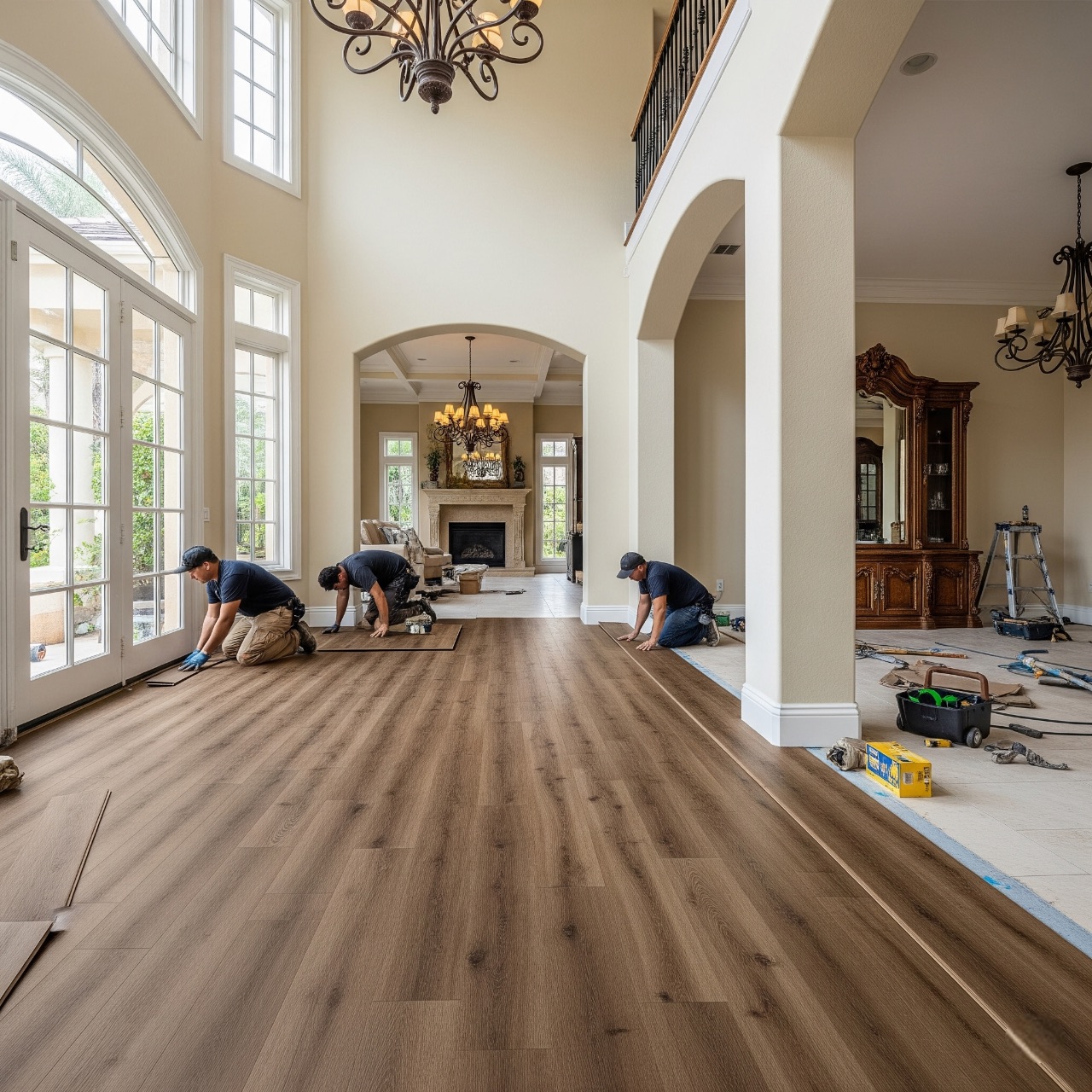Sustainable and Eco-Friendly Flooring Options
The push for sustainability and eco-conscious living has recently led many homeowners to reconsider their flooring options. As concerns about environmental impact and resource depletion continue to grow, so does the demand for eco-friendly and sustainable flooring solutions.
In this comprehensive guide, we’ll explore the world of eco-friendly flooring. Whether you’re passionate about reducing your carbon footprint or simply seeking healthier and more environmentally responsible choices for your home, we’ve got you covered.
Types of Eco-Friendly Flooring
When it comes to eco-friendly flooring, there are many options. From natural materials to innovative, sustainable alternatives, today’s market offers diverse flooring solutions that cater to different preferences and needs. Let’s explore some of the most popular types of eco-friendly flooring:
- Bamboo Flooring: Bamboo is a renewable resource that grows faster than traditional hardwood trees. Bamboo flooring is durable, versatile, and available in several styles and finishes.
- Cork Flooring: Cork flooring comes from the tree of the same name. It has natural thermal and acoustic insulation properties while being resilient, comfortable underfoot, and resistant to mold and mildew.
- Reclaimed Wood Flooring: Reclaimed wood flooring gives old materials new life and is often salvaged from barns, warehouses, and other structures. It also reduces the demand for new timber while adding character and history to your space.
- Linoleum Flooring: Made from linseed oil, cork dust, and wood flour, linoleum flooring is biodegradable and non-toxic. It’s also durable, low-maintenance, and available in several colors and patterns.
- Recycled Glass Tile Flooring: Made from recycled glass bottles and other glass products, recycled glass tile flooring is an eco-friendly option that adds a unique touch to any room. It’s available in various colors and can be customized to suit different design aesthetics.
- Recycled Metal Flooring: Consider recycled metal flooring for a modern and industrial look. Made from salvaged metal materials like aluminum and steel, this flooring is durable, easy to clean, and highly resistant to moisture and stains.
Benefits of Eco-Friendly Flooring
Choosing eco-friendly flooring offers numerous benefits for the environment and your home. Let’s explore some of the key advantages:
- Environmental Sustainability: Eco-friendly flooring is sourced from renewable and recycled materials, reducing the need for new resources. Choosing this option contributes to conservation efforts and promotes responsible consumption.
- Improved Indoor Air Quality: Traditional flooring materials contain volatile organic compounds (VOCs) and other harmful chemicals that can off-gas, leading to poor indoor air quality and potential health issues. Eco-friendly flooring is often made from natural or low-VOC materials, helping to maintain a healthier indoor environment for you and your family.
- Energy Efficiency: Some eco-friendly flooring, such as cork and bamboo, offers natural insulation properties, regulating indoor temperatures and reducing heating and cooling costs.
- Durability and Longevity: Many eco-friendly flooring options are durable and long-lasting, providing excellent value for your investment. Bamboo, cork, and reclaimed wood flooring can withstand daily wear and tear, maintaining their beauty for years.
- Design Versatility: Eco-friendly flooring comes in several styles, colors, and textures, letting you achieve your desired aesthetic while staying true to your sustainability values. Whether you prefer the rustic charm of recalled wood or the modern appeal of recycled glass tile, there’s an option for every taste and design scheme.
- Support for Green Building Practices: Eco-friendly flooring aligns with green building principles and sustainability certifications such as LEED (Leadership in Energy and Environmental Design). These materials contribute to the growth of the green building industry.
Flooring Installation Tips for Eco-Friendly Options
 Installing eco-friendly flooring requires careful planning and execution to ensure optimal performance and longevity. Here are some essential tips to keep in mind during the installation process:
Installing eco-friendly flooring requires careful planning and execution to ensure optimal performance and longevity. Here are some essential tips to keep in mind during the installation process:
- Proper Subfloor Preparation: Ensure the subfloor is clean, dry, and level before installation to prevent moisture issues and ensure stability.
- Use Low-VOC Adhesives and Sealants: Many flooring materials require adhesives or sealants for installation. Choose low or zero-VOC products to minimize off-gassing and indoor air pollution.
- Follow Manufacturer Guidelines: Different eco-friendly flooring materials have unique installation requirements. Follow manufacturer guidelines to ensure proper installation and warranty coverage. Steps may include ensuring there’s proper ventilation, maintaining temperatures and humidity levels, and using recommended installation methods.
- Consider Floating Floor Installation: Floating floor installation is when the materials are not directly glued or nailed to the floor. It allows for flexibility, easier repairs, and reduced material waste.
- Opt for Reclaimed or Salvaged Materials: Choose reclaimed or salvaged flooring materials. They can reduce waste and add charm to your space. Work with reputable suppliers or salvage yards to source high-quality reclaimed flooring materials.
- Proper Maintenance and Care: Proper maintenance preserves the beauty and longevity of your flooring installation. Follow the manufacturer’s instructions for cleaning and maintenance and address spills or damage to prevent further issues.
- Dispose of Waste Responsibly: During installation, minimize waste generation and dispose of leftover materials, packaging, or debris responsibly. Recycle or donate materials when possible to reduce environmental impact.
Maintenance and Care of Eco-Friendly Flooring
Maintaining eco-friendly flooring preserves its appearance and performance. It also prolongs its lifespan and ensures long-term sustainability. Follow these maintenance tips.
- Regular Cleaning: Sweep, vacuum, and dry-mop your eco-friendly flooring to remove dirt, dust, and debris. Hard surfaces like bamboo and cork require damp mopping with a mild detergent or eco-friendly flooring cleaner.
- Avoid Harsh Chemicals: When cleaning your flooring, avoid using harsh chemicals, ammonia-based cleaners, or wax-based products that damage the surface and compromise indoor air quality. Instead, choose pH-neutral or non-toxic cleaning solutions made from eco-friendly materials.
- Protective Measures: Mats and area rugs at entryways and high-traffic areas can trap dirt and prevent scratches or wear. Use pads or coasters under heavy furniture to prevent indentations and scratches on hardwood or bamboo floors.
- Control Moisture Levels: Maintain optimal humidity levels in your home or business to prevent moisture-related issues such as warping, swelling, or mold growth. Use a humidifier during dry seasons and a dehumidifier in humid climates to regulate indoor humidity levels.
- Trim Pet Nails: If you have pets, trim their nails to prevent scratches and damage to eco-friendly flooring surfaces. Place pet mats or rugs in areas where pets frequently rest or play to protect the flooring from spills and accidents.
- Re-Sealing and Refinishing: Depending on the type of eco-friendly flooring you choose, periodic re-sealing or refinishing may be necessary to maintain its appearance and integrity. Follow manufacturer recommendations for re-sealing bamboo, cork, or hardwood floors to protect them from moisture and wear.
- Avoid Excessive Sun Exposure: Avoid direct sunlight on eco-friendly flooring to prevent fading and discoloration over time. Use curtains, blinds, or UV-blocking window treatments to protect floors from prolonged sunlight exposure, especially in rooms with large windows or skylights.
- Address Spills Promptly: Clean up spills and stains promptly to prevent them from seeping into the flooring and causing damage. Blot spills with a clean, damp cloth, and avoid using excessive water, especially on hardwood, bamboo, or cork floors, as it can cause swelling or warping.
At MMY Flooring, we’re committed to providing high-quality, eco-friendly flooring solutions that meet the needs of our environmentally-conscious customers. From product selection to installation, our team is dedicated to helping you achieve your sustainability goals without compromising style, performance, or affordability.
source https://www.mmyflooring.com/sustainable-and-eco-friendly-flooring-options/

No comments:
Post a Comment